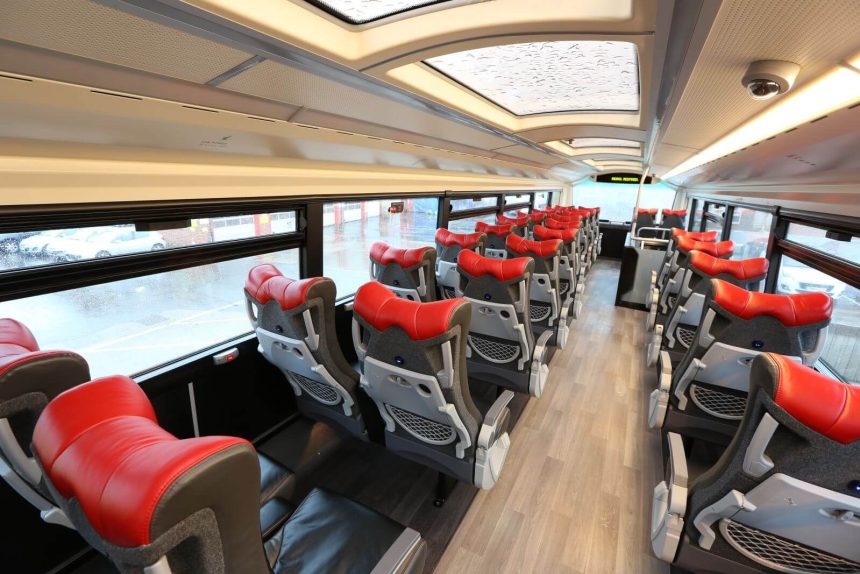If you were asked what passengers want from a bus service, you’d likely first think of punctuality, regularity and value for money. Perhaps the convenience of the routes and how safe the journeys feel are other factors you would pick out.
The design and feel of the interior might be some way down your list. However, the aesthetics and comfort on the decks are subtle yet significant influences on the passenger experience. Services such as Transdev Blazefield’s Coastliner and route 36 through Harrogate are two examples where an operator has focused on comfort and interior design as a selling point.
However, could similarly plush interiors could become more commonplace on buses rather than limited to certain flagship routes? Chris Edwards-Thorne, Marketing Manager for Altro, which makes flooring for coaches and buses, believes route 36 in Harrogate “laid down the gauntlet” and made operators think more about interiors, with a notable change seen since the most recent relaunch for that service in 2016.
“I do think we’ve seen a massive transition to be able to walk around Busworld last year and, on a Volvo bus for example, you’re seeing colours and textures which are more aligned with what you’d see in a Volvo car — which, for a public service vehicle, is quite unusual.”

He has noticed, over the last 12 months or so, manufacturers and operators starting to think more about the interior and particularly how the seating design aligns with that of the flooring. “The interplay between seats and flooring is being considered far more as one thing together now,” says Chris, who works for a business that was founded in 1919. “You can’t realistically do it in isolation. It’s only possible when you see a sizeable example of what the floor looks like and match it to those patterns and bring the lights out.”
For that reason, Altro works closely with Camira, which provides fabrics for the coach and bus market. “There’s a nice parallel there because we’re both British manufacturers and the relationship between the moquette and the floor is so important to get that balance right,” Chris says.
The rise of digital print
Via acquisitions over the years of Bradbury Fabrics of Huddersfield and John Holdsworth and Co of Halifax, which were founded in 1783 and 1822 respectively, Camira has behind it a 250-year long history of supplying textiles for the transport world. However, the West Yorkshire-based company has moved with the times and is leading innovation in coach and bus seating.

One of the new technologies it is driving is Camira Print, which uses digital printing to allow the ultimate flexibility in custom designs with lower minimum order quantities and shorter lead times.
Camira Transport Manager Nigel Vickers says the innovation is starting to gain traction in the UK, having already proven popular in overseas markets. “There are 90,000 colours; you’re not tied into the four to six colours of a traditional moquette,” he says. “One of the big selling points is the possibilities for advertising. One of the other things operators like is that they can use their own branding. Another unique selling point is that they don’t have to order the traditional 400 metres, so it’s good for smaller operators that only have three or four vehicles.”
Altro is also offering digital print as an option, recently kitting out the Alexander Dennis Enviro100EV and Enviro400EV vehicles which launched last autumn. Chris agrees that the advent of this technology will have far-reaching implications for the sector when it is fully exploited. With regards to innovations such as these, Chris speaks of operators being “cautious” while Nigel adds: “I think operators are often scared of change.”
“It’s a relatively new technology, but I think it will become more prevalent within the industry,” says Chris. “We’ve been discussing with operators how you could use it to represent the community that you serve. So many of our British cities have a really strong identity for something or another.”
For example, the fabric for the Hereford City Zipper buses which went into operation in November 2023 was supplied by Camira. The bold designs feature apples and pears on the seating material in recognition of the county’s long-established link with cider. “You could do that with so many places across the whole of the UK and it’s a talking point and it says we’re celebrating the community that we serve,” adds Chris.
Comfort and wood-effect trends
Aside from this gradual take-up of the new print technology, Nigel notes a cyclical nature to trends in bus fabrics and says the current move is towards comfort.
“Over the last five or six years, we’ve seen operators move from flat wovens to try to make the buses look more like the automotive section and hoping that would get people onto the vehicles,” he says. “The trend at the moment, though, is comfort. I think operators have realised that, coming out of the pandemic, to get people back on buses, people want comfort, be that on a short or long journey.”
From his point of view, Chris observes that wood-look flooring is continuing its advance seen over the last few years, while natural looks are gaining in popularity now too.
Sustainability and accessibility
Two issues which are increasingly factors in the world of coach and bus interiors are neurodiversity awareness and sustainability.
Chris says: “People with autism, for example, are really inhibited when it comes to public transport. Operators we work with are now more open to hearing these sorts of things and realising there are a huge amount of passengers out there who might not be able to use the bus just because a particular stimulus on the bus is debilitating to them.
“Small increments of change to make sure you balance all of these visual and physical stimuli inside the interior together at the outset can have very little cost but can have profound effect on the amount of people you can get onto your bus.”
I think, whereas safety has always historically been a mandatory thing that you’d have to comply to be specified onto a vehicle, sustainability will become equally as important – Chris Edwards-Thorne
Both Nigel and Chris admit improving sustainability while meeting safety standards can be a challenge. Nigel says: “Our product is one of the most sustainable there is, being a wool product — until we have to meet the safety standards and add the backcoat or chemicals. But, in the background, we continue to work on new things with the chemists to make the product more environmentally friendly.” That includes investigating fabrics based on plastic ocean waste.
Altro, which is a multinational company with headquarters in Letchworth, built its reputation based on safety flooring and Chris says that aspect will never be compromised on, although he adds: “I think, whereas safety has always historically been a mandatory thing that you’d have to comply to be specified onto a vehicle, sustainability will become equally as important.”
While the vinyl in safety flooring is highly recyclable, Chris says, the chips that make it non-slip need to be extracted from it first. A new product it is bringing to market is aimed at making that process simpler. It has also reduced the weight of its safety flooring by about 20%, which helps buses use a little less energy.
The difference may be subtle. But, much like the impact on passengers of interiors in general, it is not an area to be overlooked.











